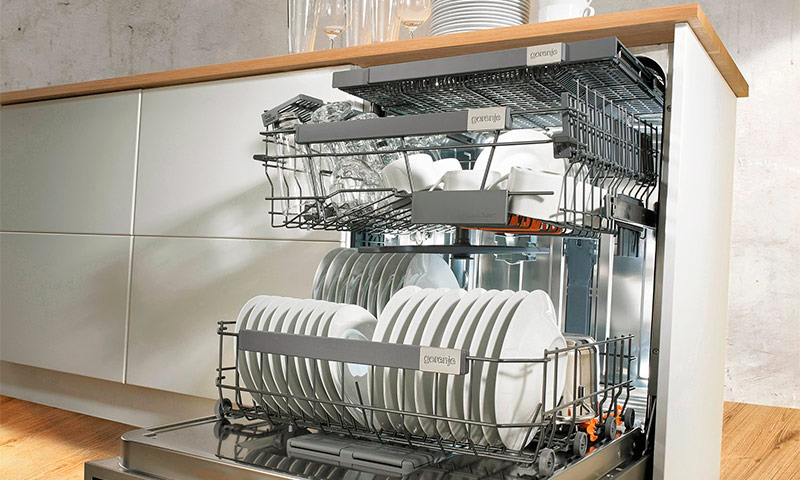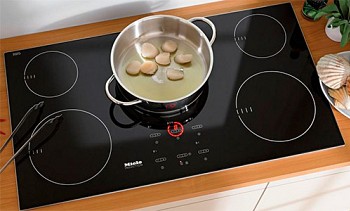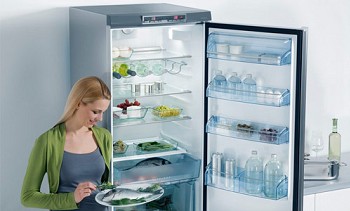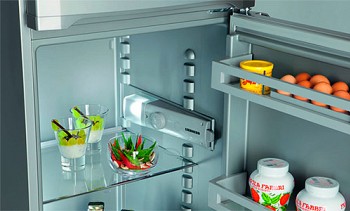How you will be satisfied with the quality of washing dishes in your dishwasher depends not only on the brand of the unit and, therefore, its capabilities, but also on how responsibly you yourself will approach this process.
What is needed for a dishwasher? What special preparations besides detergent do she need? How to place dishes in the chamber? What care does your assistant need? If you hope to achieve the perfect result, if you want your dishes to always shine with cleanliness, listen to our tips.

Content:
How to load dishes in the dishwasher
The effectiveness of washing depends largely on how correctly you load all your plates, cups, cutlery, pans and pans into the dishwasher. If you neglect a number of recommendations regarding the placement of dishes in the dishwasher chamber, the result may not please you. At the same time, you will sin not on yourself, but on your “assistant”, and in vain ...
All modern dishwashers, with the exception of supercompact models, are equipped with two baskets for dishes, as well as a cutlery tray. The upper basket is designed for plates, cups, glasses, glasses and other relatively small items. If your dishwasher provides for height adjustment of the upper basket, select its optimal position: the water should uniformly moisten all loaded dishes.

Upper basket of the dishwasher.
Specialization of the lower basket of the dishwasher - pots, pans, baking sheets, large plates and dishes and other large items. In many models, the lower baskets are equipped with reclining holders. In the raised position, these holders help to evenly distribute the dishes. But if there are too many dishes or the load of utensils is very large, the holders can simply be folded - you will get an even platform for large items.

Lower basket of the dishwasher.
The cutlery tray is, in fact, a small removable basket in which spoons, forks, table knives are placed. Premium dishwashers often have an aluminum tray designed specifically for silver cutlery.

Removable cutlery basket.
Tips for placing dishes in the dishwasher
Tip 1.
Before loading dishes into the machine, be sure to remove large pieces of food, seeds, napkins, etc. from it. This will prevent the situation when the filter clogs right during the cycle.
Tip 2.
To reduce energy consumption and at the same time improve the quality of the final result, rinse particularly dirty and greasy dishes first with hot water from the tap. A stream of hot water will remove the most severe pollution, thereby you will help the machine to better and faster cope with the task. This advice is especially relevant for dishwasher owners who do not have a pre-soak mode.
Tip 3.
First load large items into the lower basket, then small items into the upper basket.
Tip 4.
Plates, saucers, tureens are located inner side to the center. Large plates should be placed in the peripheral parts of the basket, small ones closer to the center. When placing the plates in the holders, make sure that there is a slight gap between them: being too close to each other they may not be washed properly.
Tip 5.
Cups and glasses should be installed on special holders with the bottom up, so that water does not accumulate in them. Fragile glasses of crystal or thin glass should not touch each other and with the "neighbors" in the basket, otherwise there is a good chance that after washing happiness in your house there will be more and fewer glasses.
Tip 6.
Place cutlery in the tray with the handles down - so it will be better to drain water from them.
Tip 7.
It is advisable to wash dirty dishes (pans, pans, baking trays) separately from relatively clean plates and glasses. Try to place the baking sheets from the oven in the dishwasher sideways so that they do not impede the ingress of water to the top-level dishes. But pots and pans are better to turn upside down.
Tip 8.
Do not overload the dishwasher! Do not put the dishes in it “mountain”! Water should have free access to the surface of each pan, each plate, each glass, otherwise after washing you will still get dirty dishes. Be sure to make sure that the dishes loaded into the dishwasher do not interfere with the free movement of the rocker arms rotating around its axis, from which water is sprayed during the process.
Handled loading dishes into the dishwasher? And now again carefully examine its contents and make sure that everything placed there is allowed to be washed in dishwashers.
What you can not wash in the dishwasher
In the dishwasher you can wash almost everything - from fragile glass goblets to pans and baking sheets. But there are exceptions to any rule: you can wash some items in the machine only once - the first and last. Not every material can withstand a long stay in water, high temperature, exposure to aggressive chemicals, forced drying with hot air.
We will figure out which dishes cannot be washed in the dishwasher, especially if the latter has a limited choice of washing modes.
Wood
If you do not plan to send your favorite rolling pin or wooden spoon to the landfill in the near future, refrain from washing them in the dishwasher. The result of this action is predictable. With prolonged contact with water, the wood tends to swell - the fibers, when saturated with moisture, increase in size.
Subsequent drying leads to a sharp compression of wood fibers and, as a consequence of this, to the breaking of the strong bond between them. As a result, the wooden object is deformed, its surface becomes rough, cracks appear, in a word, the product loses its appearance.
We hasten to reassure those who believe that in a short time the dishes are in the chamber of the dishwasher, nothing terrible will happen. In fact, the tree begins to swell, lying in cold water for only 30-40 minutes. What can we say about hot water, in which detergent is still dissolved ... What do you think will happen to your wooden bowls, spoons, cutting boards, rolling pins, shovels for pancakes, which will be in such conditions for 2-3 hours?

Plastic
It is possible to wash the plastic in the dishwasher, but with one caveat - it must be heat-resistant (in this case there is an icon on the product that allows automatic washing).
However, even dishes made of heat-resistant plastic are undesirable to be placed in the lower basket, i.e. near the heating element. In no case should disposable plastic cups, plates, spoons or forks be in the machine chamber.
Separately, a few words should be said about evacuated dishes. Plastic containers, from under whose lids you can pump out air, creating a vacuum inside, also can not be put in the dishwasher. Even a slight deformation of the plastic as a result of exposure to high temperatures will cause the vacuum cookware to lose its tightness and air to penetrate into it.

China
Do not automatically wash porcelain products, especially thin ones. Under the influence of hot water, porcelain can quickly become covered with a network of small cracks, turbo-drying is very detrimental to this material. In addition, after several washes, the painting will fade, not protected by a layer of varnish. If you nevertheless decide to send porcelain to the dishwasher, select the “Delicate sink” mode with a low temperature and a short cycle.

Crystal
Crystal also does not belong to "lovers" to take hot baths. He is afraid not so much of high temperatures as of their differences. As in the case of porcelain, the delicate sink mode is recommended for crystal. Especially valuable items are best washed by hand.

Noble and base metals
Automatic washing is contraindicated in certain metal products. For example, you should not load silver cutlery into the dishwasher: silver turns black from contact with some other metals (stainless steel is especially dangerous for it, from which the inner walls of the chamber are made).
Under the influence of detergents, the surface of products made of silver, brass, tin, bronze dims, and it is very difficult to achieve the initial shine.
It does not tolerate prolonged exposure to hot water and detergent and copper: in such aggressive conditions, copper objects, as a rule, darken and lose their appearance.
Aluminum is a chemically very active metal, although in ordinary life we don’t notice this due to the protective oxide film on its surface. However, this film is sometimes not able to protect against the action of a detergent solution in hot water: having been in the dishwasher, aluminum products often acquire a dark gray coating.
After the second or third washing in the dishwasher, it will be coated with a corrosive coating and lose its appearance and cast iron dishes.
Other
Nothing to do with sharp kitchen knives in the dishwasher. Professionals wash their knives under a stream of cool water, because otherwise they will quickly become dull. If you practice washing kitchen knives in a dishwasher, then you will have to sharpen them almost every day.
Do not put unglazed clay dishes and art objects in the dishwasher: clay microparticles will quickly clog filters.

If the manufacturer of your thermos or thermo mug has not provided your product with a badge permitting machine washing, you will have to manually gloss over. Plastic items, the individual elements of which are connected by glue, also have no place in the dishwasher.
We, as we could, tried to answer the question, what kind of dishes cannot be washed in the dishwasher. Of course, the full list of “prohibited” items and materials is much wider. But, we hope you understand the principle and, therefore, do not make fatal mistakes.
What tools are needed for a dishwasher
For the effective operation of the dishwasher, in addition to water, she needs a lot of different chemicals. First of all, we are talking about regenerating salt, rinse aid and, of course, detergent. Consider the purpose of each of them.
Regenerating salt
Regenerating salt is involved in the water softening cycle. Washing dishes with hard water (namely, it is in many densely populated regions of our country) is not recommended. This leads to a decrease in the effectiveness of the detergent (and, therefore, the whole process), to fouling with a layer of scale of the heating element (and, consequently, to an increase in the cost of electricity for heating water), to premature failure of some units of the unit.
To reduce the hardness of water, due to the presence of magnesium and calcium ions in it, and thereby prevent the formation of scale in the dishwasher, ion-exchange resin helps. This resin filled a special filter through which water entering the machine from the water pipe is passed.
The ion exchange resin takes calcium and magnesium ions from the water, giving away sodium ions in return. Thus, it makes the water softer.Obviously, the reserves of Na-ions in the ion exchanger are not infinite, and therefore, they must be replenished as necessary. It is this function that the regenerating salt performs.
Salt is loaded before the start of the process in a special container located at the bottom of the chamber.

At the end of the dishwashing cycle, when it was last rinsed, saturated brine was injected into the ion exchanger, which remained there for 15 minutes. This time is enough for the ion exchange resin to be freed from magnesium and calcium ions and saturated with sodium ions.
The consumption of regenerating salt is about 1.5 kg per 20 washes and depends on the degree of hardness of the water in your village. You can try to find out the value of water hardness in the local housing and communal services, although it will probably be easier to evaluate it yourself using special indicator test strips.

In accordance with these data and the stiffness table provided in the manual, set the appropriate value on the regulator of the dishwasher so that the ion exchanger picks up the right amount of salt.
The indicator on the dashboard will tell you when the supply of salt in the tank will come to an end so that you can pour a new portion on time.
Detergent
Choosing a detergent is not an easy task: with such a rich assortment of special chemicals in the modern market it is very difficult to give preference to any particular brand. Indeed, the detergents for dishwashers available on sale today differ not only by the manufacturer, but also by the form of release (powder, tablets, gel).
The main thing that every user of specialized dishwashing equipment should firmly understand is that only special detergents are allowed in the dishwasher. No cleaning or washing powders, soap, dishwashing liquid by hand!
Violation of this rule is the right way to a repair shop, or even to a landfill. Even if the machine does not fail, it will not be able to work with such an “alternative” detergent: due to excessive foaming, air jams will appear in the pump of the machine and the flow of water to the rocker arms will stop.
The most common forms of dishwasher detergent are powder and tablets.


The latter are more convenient to use and dose (some even have special notches for breaking to be used when the machine is half loaded). However, the tablets also have their drawback: they are not recommended for use in short cycles, since the tablet simply does not have time to completely dissolve. In addition, they are usually more expensive than powder.
Rinse aid
And finally, the last thing you need for a dishwasher is a rinse aid. It is designed to facilitate the draining of water from dishes and to create a protective film invisible to the eye on its surface. It is thanks to the rinse aid on the washed dishes that there will be no cloudy traces of dried drops of water, which is especially important for wine glasses and glasses made of glass and crystal, as well as for stainless steel products. Rinser is available in the form of a special liquid, which is poured into the appropriate compartment on the inside of the machine door.

Of the optional special equipment for the dishwasher, you can select a freshener (Fresh). It will give your freshly washed dishes a pleasant lemon aroma.
Today on sale you can find multilayer multifunctional tablets. Each layer of such a tablet performs its function. For example, one provides an intensive washing of dishes, the second acts as a rinse aid, the third replaces regenerating salt, the fourth clean the inside of the machine from deposits of fat, the fifth provides the luster of stainless steel, etc. Such combined pills are very expensive. In addition, many housewives, having used them, come to the conclusion that it is still more convenient to use each supplement individually.

The correct choice of operating mode
Having loaded the dishes into the baskets, making sure that all of them are subject to automatic washing, filling and filling up all the means necessary for the dishwasher to work, you can proceed to the next step - choosing the operating mode.
A dishwasher, depending on the model, can have up to a dozen (and sometimes more) different programs. Of course, we will not talk about all the possible options, we will consider only the main modes that most machines are equipped with.
Soak
We begin our review with the Soak program. It is intended for pans with traces of burnt food, as well as for dishes that have waited too long for their time, and therefore it contains the remains of frozen fat and dried starch (the latter are rich in potatoes, pasta, cereals). The machine will soak, and then wash away all these dried up pieces that were once food, even without the use of detergent.
Washing pre-soaked dishes will be much easier for her. However, it should be noted that although the dishwasher is able to cope with dried up and stuck leftovers of food, it is recommended to wash such contaminants on their own under the tap before placing the dishes in the chamber of the machine.
Intensive washing
The Intensive Wash function is available in most modern dishwashers. This mode is intended for washing heavily soiled dishes (pans and pots, plates with dried food, greasy dishes) and includes the stages of preliminary and main washing.
The temperature at which the process occurs can vary from 65 to 70 ° C, and in some models even reaches 80 ° C. At the same time, the machine “spares” water and energy, so we recommend choosing “Intensive Wash” only in those cases when you are sure that in other modes the technician will not be able to cope with the task.
Standard mode
The standard mode, called by each manufacturer in their own way, often called “Normal Washing”, is suitable for washing dishes of moderate pollution, including freshly used pots and pans. The standard program is carried out at a temperature of 60-65 ° C, and the cycle duration does not exceed 1-1.5 hours.
Economical washing
Those who are not accustomed to throwing money away should like the program “Economic washing” (“Eco”, “Economy”, “Eco-mode”, etc.). The power consumption in this mode is significantly reduced due to the low temperature of water heating - 50-55 ° C. By the way, the Half Load program will also help save your money. It is indispensable in cases where there is not a lot of dirty dishes accumulated. The process will not only be cheaper due to reduced consumption of water and electricity, but it will also take less time.
Quick wash
Those who are always in a hurry will like the “Quick Wash”, designed for slightly soiled dishes. The process, as in the economy mode, is carried out at a temperature of 55 ° C, but its duration is much shorter.
Delicate sink
Remember that objects made of thin glass, crystal or porcelain require particularly careful handling: if they come into contact with a solution of detergent in too hot water, they may lose their splendor. For washing such dishes, the Delicate Sink function is intended. In this mode, the temperature inside the chamber does not rise above 40-45 ° C.
True, the “bathing” of dishes in such semi-cool water will not help to relieve it of strong pollution, and if you have already launched your glasses and glasses so much, you will have to wash them by hand. If a variety of dishes are loaded in the dishwasher, including the one recommended to be washed at a low temperature, we recommend choosing a gentle mode.
As you can see, the main criteria for choosing a dishwashing mode are its quantity, the degree of contamination, and the material from which it is made. It seems to be nothing complicated, so why not shift to the technique not only washing the dishes, but also solving the issue of choosing the appropriate mode.
This will be possible if you purchase a dishwasher with the “Automatic washing” function. Working in this mode, the machine itself will evaluate the amount of loaded dishes and the degree of contamination, and then, taking into account these data, they will select the most optimal temperature for heating water and the duration of the process.
Impressive, but we would advise you not to rely entirely on automation. Often the equipment, trying to please the owner, is “reinsured” and unnecessarily increases the washing time. If it seems to you that the unit, working in automatic mode, is very time-consuming and consumes too many resources, return to self-selection of the right program, because the correctness of the choice depends on how much the result will meet your expectations.
Dishwasher Care
To ensure the smooth operation of the dishwasher, you need to pay at least a little attention to it. Do not be dismissive of technology, especially since caring for it will not take you much time.
After removing the washed dishes from the machine, you need to remove the strainer located above the drain hole at the bottom of the chamber, shake the accumulated food waste particles out of it and rinse the mesh under a powerful stream of water.

Small pieces of food sometimes get stuck under the door of the machine or under the rubber band, of course they also need to be removed. It is very advisable to wipe the walls of the washing chamber with a dry rag each time. Even if you are not too lazy to do this, the car door should be left open for a while - this ensures that the dishwasher chamber completely dries out, which means you will be spared the problem of the appearance of an unpleasant smell.

Three to four times a year you need to carry out a full cleaning of the dishwasher. Using funds from grease and scale, you can eliminate accumulated deposits not only in the farthest corners of the chamber, but also on the structural parts that are in contact with water and hidden in the hoses. We advise you not to spend awkwardly big money on the purchase of miracle tablets widely advertised on television, but to buy the simplest descaler is inexpensive, but quite effective.
Such simple manipulations will allow you to always keep your dishwasher clean, and she will reciprocate - she will do her job properly, without thinking of a temporary rest under the pretext of the need for a long repair.









